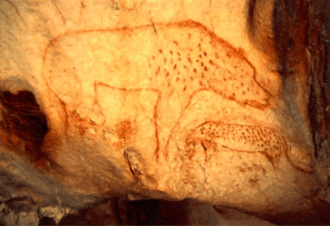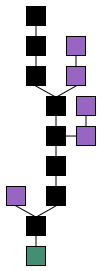Data is everywhere around us. Nowadays we collect, measure, analyze, (try to) interpret it.
However data exists since the time that humans started communicating with each other and have had the need to store information. The first data storage was probably the first human who wanted to express what was going on in their mind, by carving a cave wall.
We will never know the reason why the humans started painting caves. Expressing need for communication, leaving a trace, save information in order to share them or to remember them?
The oldest cave paintings have been discovered in Spain and are probably older than 64000 years. source
Ever since, humans have taken giant leaps in terms of communication, sharing knowledge, storing information.
Databases
Fast forwarding to the years after the mass computer adoption, came the databases. Organized data, that could be securely stored and retrieved as needed, when requested.
There are many different types of databases. Most of them are in a centralized form. This means that they are centrally controlled. Simply put, someone has the keys. If this someone (entity, computer) is compromised, the data base can be stolen, destroyed, gone.
Let's think about a Hospital and all the patients' data stored in their hospital program. What if the database server dies? What if they get hacked? Or if for any reason they lose these files or access to them? The data will be lost; for ever.
There can be hundreds of similar examples, but my aim is not to bore you with many details. With this post I aim to start a series of blogs in order to explain to a simple user how blockchain technology works, what it offers, why it is considered to be a break through and if it indeed leads or has brought the fourth industrial revolution.
Blockchain simply explained
Think of a set of blocks, linked with each other. Every block contains information about all transactions, from the first ever transaction (contained in the genesis block) to the current moment.
The blockchain is stored in computers that communicate with each other in a direct way called peer to peer (also seen as P2P)
Why is blockchain considered to be so important?
Because the data is valid, stored and protected in an ultimately secure way, mathematically & cryptographically.
Data Validity
The information/transactions confirmed are validated via cryptography, therefore it is impossible for them to be compromised.
Data Transparency
The data is publicly viewed. There is no privacy, anyone can have access to the information stored. For instance if you visit the Official Blockchain Website you will see current information about every transaction made, ever.
Availability
Anyone with a computer or a mobile phone can have access to the technology. Anyone having access to internet and a smartphone could make transactions and communicate with a person in the other side of the world.
Permanency
“Our ancestors said, "This is as good as written in stone." Our grandchildren will say, "It is as good as written on the blockchain.”
― Andreas M. Antonopoulos, The Internet of Money Volume Two
This explains perfectly how permanent information that stored in the blockchain is. If it is stored, it will for ever exist as a record. It cannot be altered or deleted.
Transferability
The blockchain stores assets in a digital way, and the owner of such assets can easily transfer them to anyone else.
In addition to the above, every blockchain has its own possibilities, so we will make sure to discuss more in the near future in regards to the specific block chain we will examine
Let's start with the Genesis Block
It was January 3rd*, 2009 when the first block of the Bitcoin blockchain was created. The reward was 50 Bitcoins transferred to an address we know not who the recipient (if any) was.
But it all started before that, the distributed ledger was an idea that Satoshi Nakamoto was the first to actually implement into what we know as the Bitcoin Blockchain.
As mentioned by Digital Trends, a paper of 1976*, called New Directions in Cryptography by Whitfield Diffie & Martin E. Hellmann, discusses the widening of cryptographic applications in order to minimize the need for secure key distribution channels and supply the equivalent of a written signature
Later on, in 1990*, Stuart Haber and W. Scott Stornetta would publish a paper regarding their suggestions about How to time-stamp a digital document
The great discoveries do not just happen. There is a great amount of work, of innovative thinking and progressive steps that lead to a break-through, for which all the world is talking about.
In the words of Mr Antonopoulos
“When bitcoin was created by Satoshi Nakamoto, the software was actually completed before the whitepaper reproduced in Appendix A was written. Satoshi wanted to make sure it worked before writing about it. "
― Andreas M. Antonopoulos, Mastering Bitcoin: Programming the Open Blockchain
Not Final Words
The Blockchain technology went merely unnoticed when it was first introduced. Today, almost a decade later, it is being considered to be a part of the 4th Industrial Revolution* and every industry is searching of ways to implement it for efficiency and development.
One thing is for sure, block chain technology is here to stay, having for ever changed the way we can handle / store and use data.
We owe it to ourselves and to the next generations to be educated, to be prepared. To embrace the new and to use it for good.
Thank You

References & further reading
http://blockchain.mit.edu/articles/
https://www.technologyreview.com/s/610833/explainer-what-is-a-blockchain
https://link.springer.com/article/10.1186/s40561-017-0050-x#CR12
This is the first of a series of articles that will be about this disruptive new technology. We will try to understand how it works, how it evolved and how it can be implemented. Also, what the dangers may be and things to be aware of. Any comments are always welcome and appreciated.

If you write about Science, Technology, Engineering, Mathematics you are invited to join us at @steemstem! Come meet a community of like minded steemit users that write to make the world and steemit a better place!



